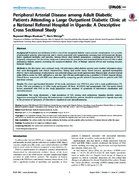| dc.description.abstract | Peripheral arterial disease (PAD) is one of the recognised diabetic macro vascular complications. It is a marker of generalised systemic atherosclerosis and is closely associated with symptomatic coronary and cerebrovascular disease, hence significant morbidity and mortality. Among African adult diabetic populations, screening and diagnosis of PAD is frequently suboptimal. The aim of this study was to determine the prevalence and associated clinical factors of PAD in adult ambulatory diabetic patients attending the outpatient diabetic clinic of Mulago national referral and teaching hospital, Kampala Uganda.
In this descriptive cross sectional study, 146 ambulatory adult diabetic patients were studied. Information about their socio-demographic and clinical characteristics, fasting lipid profile status, blood pressure, glycated haemoglobin (HbA1c) levels and presence of albuminuria was collected using a pre tested questionnaire. Measurement of ankle brachial index (ABI) to assess for PAD, defined as a ratio less than 0.9 was performed using a portable 5–10 MHz Doppler device. Clinical factors associated with PAD were determined by comparing specific selected characteristics in patients with PAD and those without.
Results: The mean age/standard deviation of the study participants was 53.9/12.4 years with a male predominance (75, 51.4%). PAD was prevalent in 57 (39%) study participants. Of these, 34 (59.6%) had symptomatic PAD. The noted clinical factors associated with PAD in this study population were presence of symptoms of intermittent claudication and microalbuminuria. This study documents a high prevalence of PAD among adult ambulatory Ugandan diabetic patients. Aggressive screening for PAD using ABI measurement in adult diabetic patients should be emphasised in Uganda especially in the presence of symptoms of intermittent claudication and microalbuminuria. | en_US |


